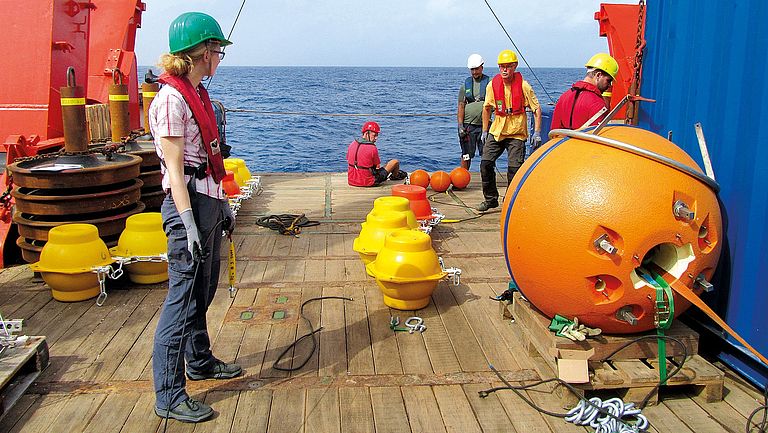53N array and mooring K1
Since 1997, GEOMAR has operated several moorings in the Labrador Sea, the marine area between Canada and Greenland, to continuously measure the deep western boundary current and deep water formation as part of the Atlantic overturning circulation. The boundary current meanders southward along the western edge of the Atlantic Ocean at depths of more than two kilometers. In the course of climate change, a weakening of the circulation is expected in the long term - but so far this could not be confirmed with the data from the 53°N array and the mooring K1 of GEOMAR.
Cape Verde Ocean Observatory (CVOO)
About 100 kilometers northeast of the Cape Verde Islands, GEOMAR operates the oceanic time series station CVOO together with facilities from Cape Verde since 2006. With the help of the moored sensors, data can be collected continuously over the entire water column with very high temporal resolution. The measurements at CVOO provide time series of important biogeochemical and biological variables such as carbon and oxygen content, phytoplankton and zooplankton concentration. Physical parameters such as current, temperature, and salinity are measured as important oceanographic frameworks at particularly high resolution.
23W Array
In the central Atlantic Ocean, GEOMAR operates a mooring in cooperation with the international PIRATA program to record the current systems along the equator. The mooring time series, which was started in 2001, contributes significantly to a better understanding of climate variations in the tropics and their predictability. This mooring has provided evidence of both approximately five-year variations in the deep ocean and ten-year changes in the surface circulation.
Angola Array
GEOMAR's newest long-term observing stations are several moorings off the coast of Angola. There, directly in the Angola Current, GEOMAR has been studying the upwelling of cold, nutrient-rich water since 2013. Among other things, it ensures a pronounced biological productivity in the nearshore marine areas. Here, the researchers not only want to understand climate processes, but also clarify the contribution of physical processes to the high biological productivity and the abundance of fish off the coast of Southwest Africa.
11S Array
The Brazilian continental slope is so particularly suitable for observing transport variability because the warm surface and cold deep currents can be recorded simultaneously here. Several moorings survey the northern Brazilian lower current and the deep western boundary current at 11 degrees south. Here, in the upper 1,000 meters, warm water from the subtropical South Atlantic and Indian Ocean is transported northward. One story deeper, between 1,000 and 4,000 meters of water depth, cold water flows south. This is the continuation of the flow measured by the 53°N array.










